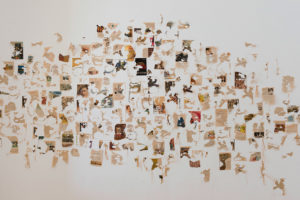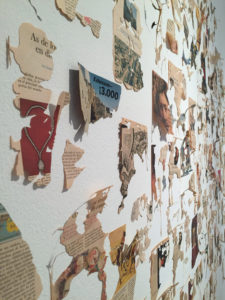 Busca una pista, inventa la historia
Busca una pista, inventa la historia
(Search a track, invent history)
Lourdes de la Riva
3,50 m x 4,70 m
2016
Remains of small sections of paper books perforated by the moths and attached to the wall
The mural collage “Busca una pista, inventa la historia” (Search a track, invent history) from 2016 by Lourdes de la Riva was exhibited at X Biennial Centroamericana, San José, Costa Rica. It is not what it seems to be at first glance. One might think of a map of newspaper cuttings. A closer look cannot confirm this. Even the origin of newspaper is doubtful. Could it be magazines? In addition, it is ambiguous how the artist has made the snippets. Certainly not with a knife or scissors, because the edges are not sharp enough. On the other hand, the paper could not be ripped, since the brinks are too delicate.
In consequence, we need to search for a track to understand what is on view. “Busca una pista, inventa la historia” is part of the series “Los Creadores” (The Creators), on which Lourdes works since 2011. In her research of traces that nature left in human civilisation, she became aware, that moths have their own life within human inventions. Having no consciousness about one of mankind’s most important creations, books, they eat them silently. Doing so, the moths are giving a – for them appropriate – new sense to the printed-paper. Even though these animals are destroying records of human ideas, so important for us, they are creating something new. Nevertheless, it is a process in constant transformation, until someone stops them. Each stage is ephemeral.
This impermanence is important to Lourdes. In her artworks, she is reinterpreting the accomplished work by the insects. She questions if humanity could eventually lose the fight to dominate nature by recklessness or abandon. The leftovers of the moths should animate to rethink history, as the title of the oeuvre suggests and to reflect about the conditions and difficulties of our time. Could the first impression of a map not be so incidental? Perhaps it is a hidden link to our world as geographical component, likewise a hint to the chaos produced by human activity.
 “Busca una pista, inventa la historia” reflects the instability of our existence not only by the incidental paper snippets. It is a witness of another order caused by the activity of the insects. Even the uncertainty about the origin plays its role, because without further information the observer cannot derive it. Due to the perforation, the material got more fragile. The installation directly on the wall provokes the difficulty to transport it to another place without being changed. Nevertheless, the showrooms in the National Museum of Costa Rica are used for other exhibitions after the end of the X Biennial. In consequence, the oeuvre is ephemeral like the work the moths are doing.
“Busca una pista, inventa la historia” reflects the instability of our existence not only by the incidental paper snippets. It is a witness of another order caused by the activity of the insects. Even the uncertainty about the origin plays its role, because without further information the observer cannot derive it. Due to the perforation, the material got more fragile. The installation directly on the wall provokes the difficulty to transport it to another place without being changed. Nevertheless, the showrooms in the National Museum of Costa Rica are used for other exhibitions after the end of the X Biennial. In consequence, the oeuvre is ephemeral like the work the moths are doing.
Lourdes de la Riva
Born 1955 in Guatemala City, Lourdes de la Riva lives and works in her hometown. For her creations, she uses natural elements like sand, seeds and leaves as well as found objects and marks of humanity. She processes these components into sculpture, photography, video and installation.
The results show the impact that human activity has on nature and vice versa. Even though human beings are still ranking as part of nature, they consider themselves as superior to all other natural creations since the beginning of history. In consequence, humanity has left many traces of its existence, but also nature is involved to reconquer lost terrain. Lourdes focusses on these correlations and visualises the marks in her artworks.
Since 2011, she is working on the series “Los Creadores” (The Creators), from which our presented artwork is part. Here she intervenes on books, which were transformed by moths or other insects. In 2016, on the X Biennial Centroamerica in Costa Rica, she exhibited in two rooms of the National Museum in San José many oeuvres of “Los Creadores”. Besides the installations of the book remains in various forms, there were videos and photos, which illustrate the process of the moths’ activity. Moreover, there was a trunk by termites perforated, decorated with small black flags, called “La gran victoria” (The Great Victory).
Beyond that, Lourdes participated in numerous group exhibitions, especially in Guatemala, but as well in various other countries of Latin America and the United States. In 2010, her video “Dulce Proceso” (Sweet Process) was honoured during the first Triennial del Caribe y Centroamerica in the Dominican Republic. In Europe, her works were first on view in 1998 in Paris and 2012 in Madrid. This year the photo “Artificio 6” is presented in the Guatemalan Pavilion of the 57th Art Biennale in Venice. In addition, the artist had many solo exhibitions in her home country and the United States, received several awards and two of her works are installed in the public space of Guatemala City.
